- Joined
- Feb 2, 2011
- Messages
- 2,348
NEW RELEASES FOR JANUARY 2024
THE SECOND WORLD WAR
GERMAN ARMOUR
PANZERKAMPFWAGEN III Ausf. H
Bitzkrieg!
Merely mentioning the term conjures images of massed dark grey Panzers inexorably rolling across fields and crushing all opposition before them. Although the term was never officially used by the Germans, "Lightning War" is an apt description of the revolutionary combined arms doctrine the Third Reich unleashed on the world in the early years of World War Two. It brought stunningly quick victories against Poland and France and expelled the British Expeditionary Force from the European continent. However, the scale of these operations paled in comparison to the ultimate expression of Blitzkrieg: Operation BARBAROSSA...the invasion of the Soviet Union.
BARBAROSSA was the largest land invasion in history. The Germans unleashed 138 divisions (approximately 3.5 million troops ) and 36 allied divisions (approximately 700,000 troops) against Russian forces totaling 304 divisions (some 5.5 million troops). It was the beginning of truly the most epic conflict in history.
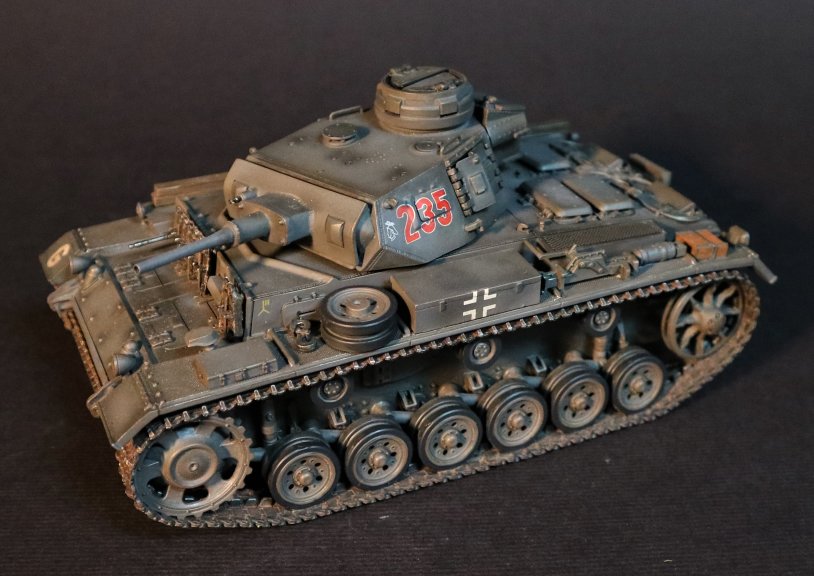
GA-30
THE SECOND WORLD WAR,
GERMAN ARMOUR,
German Panzerkampfwagen III Ausf. H (Sd.Kfz.141)
3. Panzer Division (Panzer Regiment 6)
Operation BARBAROSSA
Soviet Union, 1941.
(5 pcs)
model Size 7” x 3 ¾” x 3 ¼”
(11 ½” x 11” x 5” box size 930g weight)
Key to the Germans battle plans were the swift moving Panzer divisions. Spearheading the initial breakthroughs and ranging far ahead of the following marching infantry divisions, the Panzer forces were able to achieve heretofore unheard of victories, such as the great battles of encirclement fought at Bialystok, Minsk and Kiev (where the Germans captured 700,000 Soviet prisoners).
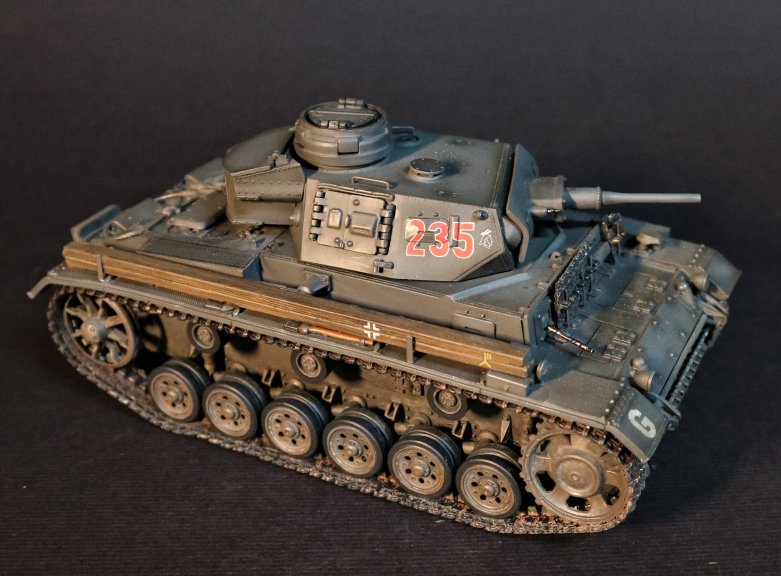
Key to these successes and at the forefront of these battles was the German's main battle tank of the time, the iconic Panzer III. Contrary to widespread belief, in the early stages of the war, the early German Panzers were often inferior to their Allied opponents. The Panzer III was no different in this regard. Initially, it fielded a 3.7 cm cannon and possessed a maximum of only 30mm of armor, the early Panzer IIIs were easily defeated by Allied anti-tank weapons, and lacked a sufficiently powerful cannon. In fact, during the Battle of France Panzer III crewmen would experience the shock of watching their anti-tank cannon shells bounce harmlessly off the thick armor of French heavy tanks.
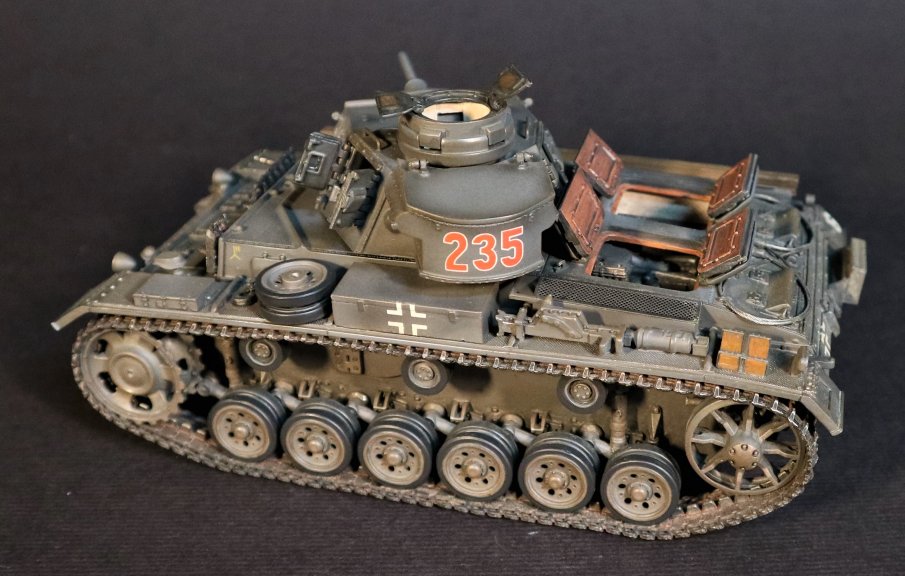
Consequently, from the beginning of the war the Panzer III saw a continuous upgrade program to increase its armor and armament. By the summer of 1941, the ultimate expression of this upgrade program was the Panzer III Ausf H. While looking very similar to the earlier Ausf F and Ausf G models, it incorporated a series of improvements. The Ausf H's hull armor was increased by bolting on additional face hardened 30mm armor plates to the 30mm base armor, resulting in a combined armor thickness of 60mm. Uniquely, this additional armor plate extended above the front hull and was secured to the panzer's hull roof. This thicker armor, coupled with the face hardening treatment that caused many Allied anti-tank rounds to shatter on impact, resulted in a tank that was impervious to all the tank guns of the Western allies when it was initially fielded. The Ausf H also carried a larger 50mm main cannon and had improved running gear consisting of the new pattern sprocket and idler wheels. Furthermore, most Ausf H were equipped with the "Tropen" engine deck arrangement, where the engine access doors carried raised armored protection that provided increased cooling to the engine. Despite these armor and cannon improvements, during Operation BARBAROSSA panzer crewmen would once again repeat engagements where horrified German tankers watched their cannon rounds harmlessly bounce off the heavy Russian T-34 and KV tanks while Russian 76mm tank cannons easily penetrated the Panzer III. Like in France the year before, the German Panzertruppen would achieve success based more on the highly skilled employment of their tanks rather than any inherent superiority of their Panzers themselves.
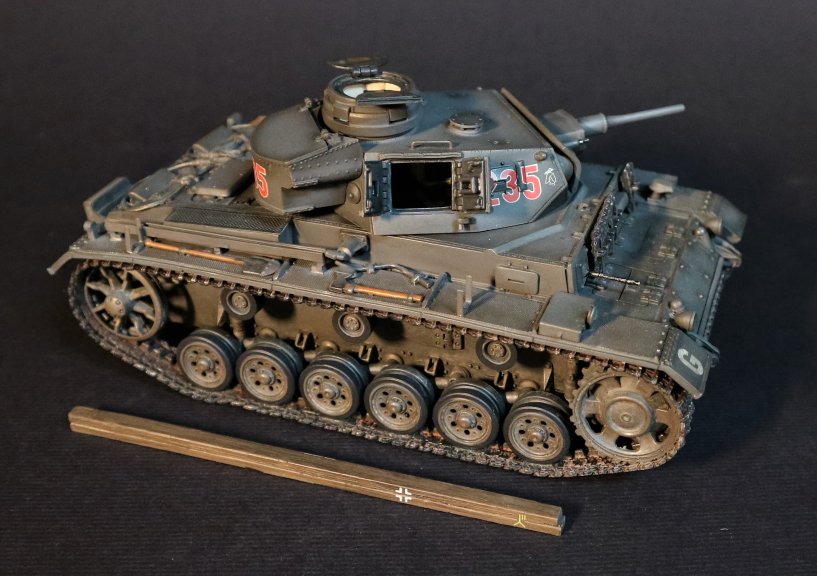
To capture the spirit of Blitzkrieg, JJD is pleased to announce the release of the Panzer III Ausf H. Painted in a solid Dunkelgrau (Dark Grey) paint job, this model depicts a tank of Panzer Regiment 6 of the 3. Panzer Division (3. Pz.Div) as it appeared during Operation BARBAROSSA. One of the storied original three Panzer divisions, personnel from 3. Pz. Div. served as volunteers in the Condor Legion during the Spanish Civil War and the entire division saw action during the occupations of the Sudentenland and Czechoslovakia. It fought at full strength during the battles for Poland and France and subsequently provided its Panzer Regiments 5 to form the 5. Leichte Division (later 21. Panzer Division) of Deutsches Afrikakorps fame. For the invasion of Russia, 3. Pz.Div. fought as part of Panzergruppe 2 under General Heinz Guderian as part of Heeresgruppe Mitte, helping to close the mega-encirclement at Kiev and later driving from the south towards Moscow during Operation TYPHOON.
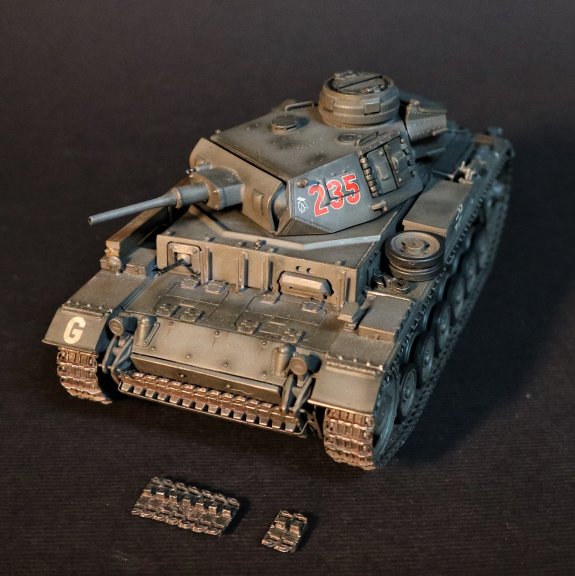
The JJD Panzer III Ausf H depicts a Panzer III Ausf H of Panzer Regiment 6 of the 3. Panzer Division and carries features and markings unique to that unit's panzers:
- red turret numbers
- removable wooden planks mounted on the right side (with division insignia painted on) used for unditching a tank from muddy ground
- mounts on the front hull for holding removable sections of track links to provide increased protection
- a stylized letter "G" on the front and rear right mudguards used by vehicles of Panzergruppe "Guderian"
- white outline insignia of a German Grenadier's head on the right and left turret sides
Additionally, the model has the following standard JJD features:
- interior detail for turret, hull, and engine bays
- turret and engine deck hatches open and close
- historically accurate paint job and markings
PLEASE NOTE THIS ITEM IS NOW SOLD OUT from JJD.
** PLEASE CONTACT YOUR LOCAL DEALER FOR FURTHER INFORMATION **
THE SECOND WORLD WAR
GERMAN ARMOUR
PANZERKAMPFWAGEN III Ausf. H
Bitzkrieg!
Merely mentioning the term conjures images of massed dark grey Panzers inexorably rolling across fields and crushing all opposition before them. Although the term was never officially used by the Germans, "Lightning War" is an apt description of the revolutionary combined arms doctrine the Third Reich unleashed on the world in the early years of World War Two. It brought stunningly quick victories against Poland and France and expelled the British Expeditionary Force from the European continent. However, the scale of these operations paled in comparison to the ultimate expression of Blitzkrieg: Operation BARBAROSSA...the invasion of the Soviet Union.
BARBAROSSA was the largest land invasion in history. The Germans unleashed 138 divisions (approximately 3.5 million troops ) and 36 allied divisions (approximately 700,000 troops) against Russian forces totaling 304 divisions (some 5.5 million troops). It was the beginning of truly the most epic conflict in history.

GA-30
THE SECOND WORLD WAR,
GERMAN ARMOUR,
German Panzerkampfwagen III Ausf. H (Sd.Kfz.141)
3. Panzer Division (Panzer Regiment 6)
Operation BARBAROSSA
Soviet Union, 1941.
(5 pcs)
model Size 7” x 3 ¾” x 3 ¼”
(11 ½” x 11” x 5” box size 930g weight)
Key to the Germans battle plans were the swift moving Panzer divisions. Spearheading the initial breakthroughs and ranging far ahead of the following marching infantry divisions, the Panzer forces were able to achieve heretofore unheard of victories, such as the great battles of encirclement fought at Bialystok, Minsk and Kiev (where the Germans captured 700,000 Soviet prisoners).

Key to these successes and at the forefront of these battles was the German's main battle tank of the time, the iconic Panzer III. Contrary to widespread belief, in the early stages of the war, the early German Panzers were often inferior to their Allied opponents. The Panzer III was no different in this regard. Initially, it fielded a 3.7 cm cannon and possessed a maximum of only 30mm of armor, the early Panzer IIIs were easily defeated by Allied anti-tank weapons, and lacked a sufficiently powerful cannon. In fact, during the Battle of France Panzer III crewmen would experience the shock of watching their anti-tank cannon shells bounce harmlessly off the thick armor of French heavy tanks.

Consequently, from the beginning of the war the Panzer III saw a continuous upgrade program to increase its armor and armament. By the summer of 1941, the ultimate expression of this upgrade program was the Panzer III Ausf H. While looking very similar to the earlier Ausf F and Ausf G models, it incorporated a series of improvements. The Ausf H's hull armor was increased by bolting on additional face hardened 30mm armor plates to the 30mm base armor, resulting in a combined armor thickness of 60mm. Uniquely, this additional armor plate extended above the front hull and was secured to the panzer's hull roof. This thicker armor, coupled with the face hardening treatment that caused many Allied anti-tank rounds to shatter on impact, resulted in a tank that was impervious to all the tank guns of the Western allies when it was initially fielded. The Ausf H also carried a larger 50mm main cannon and had improved running gear consisting of the new pattern sprocket and idler wheels. Furthermore, most Ausf H were equipped with the "Tropen" engine deck arrangement, where the engine access doors carried raised armored protection that provided increased cooling to the engine. Despite these armor and cannon improvements, during Operation BARBAROSSA panzer crewmen would once again repeat engagements where horrified German tankers watched their cannon rounds harmlessly bounce off the heavy Russian T-34 and KV tanks while Russian 76mm tank cannons easily penetrated the Panzer III. Like in France the year before, the German Panzertruppen would achieve success based more on the highly skilled employment of their tanks rather than any inherent superiority of their Panzers themselves.

To capture the spirit of Blitzkrieg, JJD is pleased to announce the release of the Panzer III Ausf H. Painted in a solid Dunkelgrau (Dark Grey) paint job, this model depicts a tank of Panzer Regiment 6 of the 3. Panzer Division (3. Pz.Div) as it appeared during Operation BARBAROSSA. One of the storied original three Panzer divisions, personnel from 3. Pz. Div. served as volunteers in the Condor Legion during the Spanish Civil War and the entire division saw action during the occupations of the Sudentenland and Czechoslovakia. It fought at full strength during the battles for Poland and France and subsequently provided its Panzer Regiments 5 to form the 5. Leichte Division (later 21. Panzer Division) of Deutsches Afrikakorps fame. For the invasion of Russia, 3. Pz.Div. fought as part of Panzergruppe 2 under General Heinz Guderian as part of Heeresgruppe Mitte, helping to close the mega-encirclement at Kiev and later driving from the south towards Moscow during Operation TYPHOON.

The JJD Panzer III Ausf H depicts a Panzer III Ausf H of Panzer Regiment 6 of the 3. Panzer Division and carries features and markings unique to that unit's panzers:
- red turret numbers
- removable wooden planks mounted on the right side (with division insignia painted on) used for unditching a tank from muddy ground
- mounts on the front hull for holding removable sections of track links to provide increased protection
- a stylized letter "G" on the front and rear right mudguards used by vehicles of Panzergruppe "Guderian"
- white outline insignia of a German Grenadier's head on the right and left turret sides
Additionally, the model has the following standard JJD features:
- interior detail for turret, hull, and engine bays
- turret and engine deck hatches open and close
- historically accurate paint job and markings
PLEASE NOTE THIS ITEM IS NOW SOLD OUT from JJD.
** PLEASE CONTACT YOUR LOCAL DEALER FOR FURTHER INFORMATION **

